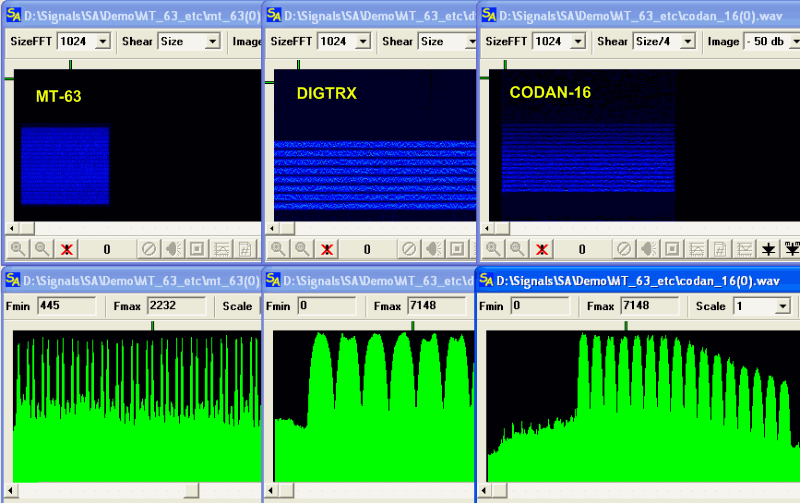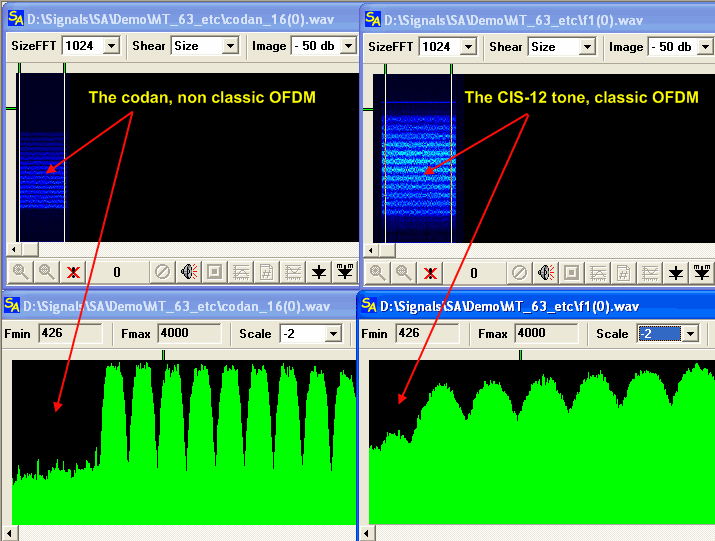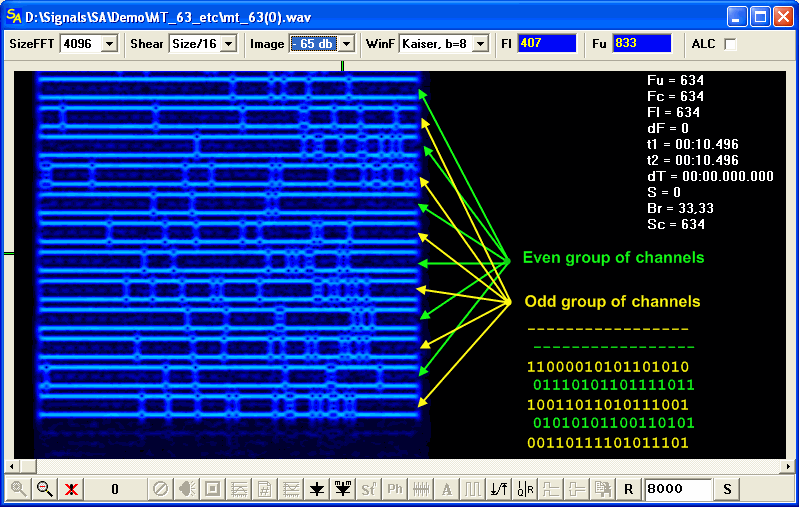|
|
| Разместил (Author): |
SergUA6  |
| Авторские права |
© http://www.radioscanner.ru |
|
|
Текст
|
Non standard OFDM signals.
Being engaged into analysis of MT-63, there was found out several similar signals. As it has appeared, it is not such rarity. Before we will start to consider MT-63 in details, we will try to understand, basically, what are specifics and features of these signals .
Probably we wouldn't pay attention to this class of co -called pseudo OFDM signals, but examination of the developed module of the analysis of OFDM, has shown that there are signals, which are generated obviously not by standard technology, at least the analyzer is "slips" a little bit on the records, which quality seems to be exellent.
Besides, some discussions on our forum were linked to this question.
There are three signals which do not fit into the standard scheme of OFDM creation.

Probably, there is nothing unusual can be visible at once, but attempts to simulate Codan-16 by the standard technology do not lead to reception/getting of adequate model. The difference will be more obvious if to compare Codan-16 with Well-known CIS-12 tone, from the point of view of the main relations of space between channels and speed of manipulation, these signals have approximaly identical structure, and thus we can expect approximaly identical spectral allocations. However distinctions are very essential.

It is well visible that Codan-16 has too obvious almost complete partition of channels, while the classical methods do not provide it. CIS-12 tone has the typical result of the classical OFDM creation , and the overwhelming majority of cases OFDM signals look same.
It is known that, sometimes the difficult enought methods are used at creation of OFDM.
For exmaple the methods of :
- reducing of out-of-band radiations
- increasing of the spectral density
- reducing of the peak-factor
But all these methods are not used untill complete partition of the channels, besides all, these methods do not distort the signals to that point, then the reverse demodulation by the classical ways becomes impossible, on the contrary, these methods are aimed to provide compatibility.
An obvious conclusion - these signals are created by other way. It is not the big secret or strong innovation, but nevertheless, it can cause complexities at the analysis, and basically, it can even to lead to incorrect results of the analysis.
Signals, which are similar to DIGTRX and Codan-16 are formed by FDM technology. Let's not go deep into details, but in general, the sense of FDM technology is: that the prototype of the one channel with the obviously established form is created, and then on the basis of this prototype, the grid of working channels is formed.
Practically the spacing can be any, orthogonality is not necessary.
It allows to reach more density of usage of the spectrum, in comparison with the classical multi-channel (not OFDM) systems.
We consider the task of analysis, not only as definition of parametres of a signal for the purpose of its identification, but also with the purpose to understand what is necessary for the signal's demodulation.
In this sense, the conclusions for Codan-16 and DIGTRX that these signals are the classical OFDM signals certainly is not true. These signals do not have CP, which "is easily calculated" from the relations of speed and spacing, they have not orthogonal grid of frequencies, and it is impossible to demodulate these signals by the classical OFDM approaches. From the point of view of analysis there should not be vaguenesses in the signal at the analysis. It is necessary to know all features of the analyzed signal and understand why these features are placed in the signal. Ofcourse it is not always possible, but one of the main goals of analysis is the full detalization of the signal and it's nuances.
Let's come back now to MT-63. Principles of creation, which were described above, had no success in case with MT-63. The signal is obviously formed by the FDM technology, but the result is not standard. Fast enough we have ascertain that the signal is divided/separated on two groups of the channels: even and odd. These groups have shift/displacement relatively each other on half-clock/tact of frequency of manipulation.

That is, as the variant, by the standard resources of OFDM technology, two independent streams of even channels and odd accordingly, are forming. CP is added in each stream, and both these streams are merged into one. It is possible to provide the shift/displacement on half-clock/tact both at creation of streams and at their merging, as the result we receive pseudo OFDM, where according to all signs/characteristics, it is classical OFDM, but all attempts to demodulate it by the standard for OFDM methods are failing.
It is not easy to get to know how it is possible to devide/separate these streams at reception/recieveing by simple methods. Ofcourse there are solutions, but it turns out difficult enough.
Besides, the sense of such creation is not really obvious, because there are no particular advantages before the classics methods, at least we had not found them.
That would be interesting to get to know: why is there the necessity of such shift/displacement of even and odd channels? And that it gives basically? Except doubtful reducing of the peak-factor and obvious, considerable complicating of the demodulator.
Good Luck.
|
|
|
|
Добавлять комментарии могут только зарегистрированные, активировавшие регистрацию и не ограниченные в доступе участники сайта!
|
| Файл создан: 23 Sep 2009 19:21, посл. исправление: 23 Sep 2009 19:44 |
|

